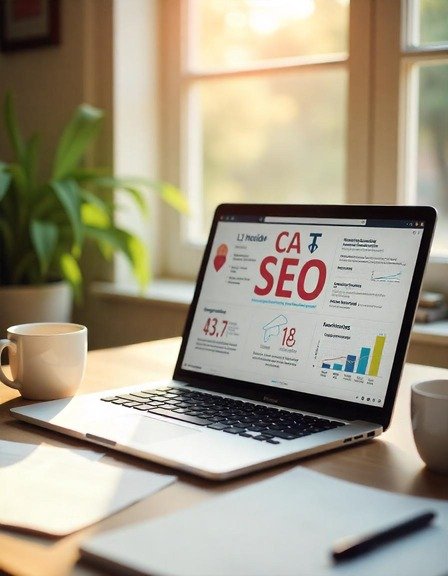Introduction
In the digital age, having a well-optimized website is crucial for attracting and retaining visitors. Search Engine Optimization (SEO) is the practice of increasing both the quality and quantity of website traffic, as well as the visibility of a website or a web page to users of a web search engine. On-page SEO, also known as on-site SEO, focuses on optimizing elements within your website to improve its search engine rankings and drive more organic traffic. This article will delve into the importance of on-page SEO and provide a comprehensive guide on how to effectively implement it. The Importance and Process of On-Page SEO Optimization.
What is On-Page SEO?
On-page SEO involves all the actions taken within a website to rank higher in search engine results pages (SERPs). It includes optimizing content, HTML source code, and images. The primary goal of on-page SEO is to make it easier for search engines to understand what your website is about and to provide a better user experience for visitors.
The Importance of On-Page SEO
- Improved Search Engine Rankings: On-page SEO is one of the most direct ways to influence your website’s search engine rankings. By optimizing your site, you can make it more relevant to specific keywords, which can help you rank higher in search results.
- Enhanced User Experience: A well-optimized website is not only beneficial for search engines but also for users. It ensures that your content is easy to find, read, and navigate, which can reduce bounce rates and increase user engagement.
- Increased Organic Traffic: Higher search engine rankings can lead to more organic traffic. Organic traffic is free and can significantly boost your website’s visibility and credibility.
- Better Credibility and Trust: Websites that rank high on search engines are often perceived as more credible and trustworthy by users. This can lead to more conversions, such as sign-ups, purchases, and subscriptions.
Key Elements of On-Page SEO
- Title Tags: Title tags are the most important on-page SEO element. They appear in search results and are the first thing users see. Make sure your title tags are concise, descriptive, and include your primary keywords.
“Your title tag is the first impression a user has of your website. Make it count.” – SEO expert John Doe
- Meta Descriptions: Meta descriptions provide a brief summary of your page’s content and are displayed below the title tag in search results. While they don’t directly affect rankings, they can significantly influence click-through rates.
- Header Tags (H1, H2, H3): Header tags help structure your content and make it easier to read. Use H1 for the main title, H2 for subheadings, and H3 for sub-subheadings. Include your keywords naturally in these tags.
- URL Structure: Your URLs should be short, descriptive, and include keywords. Avoid using unnecessary parameters and slashes. For example,
www.example.com/keyword-optimized-pageis better thanwww.example.com/index.php?page=123&category=456. - Content Optimization: High-quality, relevant content is the foundation of on-page SEO. Ensure your content is well-written, informative, and includes your target keywords naturally. Use bullet points, numbered lists, and images to make your content more engaging.
- Image Optimization: Optimize your images by using descriptive file names and alt tags that include your keywords. Compress images to reduce load times, which can improve user experience and search engine rankings.
- Internal Linking: Internal linking helps search engines understand the structure of your website and the relationships between different pages. Use descriptive anchor text and link to relevant pages within your site.
- Mobile Optimization: With the increasing use of mobile devices, having a mobile-optimized website is crucial. Ensure your site is responsive and loads quickly on mobile devices.
- Page Speed: Page speed is a critical factor in user experience and search engine rankings. Use tools like Google PageSpeed Insights to identify and fix issues that are slowing down your site.
- XML Sitemaps: An XML sitemap helps search engines understand the structure of your website and find all your pages. Submit your sitemap to search engines to improve crawl efficiency.
Step-by-Step Guide to On-Page SEO Optimization
- Keyword Research:
- Identify your target audience and their search behavior.
- Use tools like Google Keyword Planner, Ahrefs, or SEMrush to find relevant keywords.
- Create a list of primary and secondary keywords to target.
- Optimize Title Tags:
- Create unique, descriptive title tags for each page.
- Include your primary keywords at the beginning of the title tag.
- Keep the length between 50-60 characters to avoid truncation in search results.
- Write Compelling Meta Descriptions:
- Summarize the content of each page in 155-160 characters.
- Include a call-to-action to encourage clicks.
- Use your primary keywords naturally.
- Structure Your Content:
- Use header tags (H1, H2, H3) to create a hierarchy and make your content more readable.
- Break up long blocks of text with bullet points, numbered lists, and images.
- Include your keywords in the first 100 words of your content.
- Optimize Images:
- Use descriptive file names and alt tags.
- Compress images to reduce load times.
- Use responsive images to ensure they look good on all devices.
- Implement Internal Linking:
- Link to relevant pages within your site using descriptive anchor text.
- Use a consistent internal linking structure to help search engines understand your site’s hierarchy.
- Ensure Mobile-Friendliness:
- Use a responsive design that adjusts to different screen sizes.
- Test your site on various devices to ensure it looks and functions well.
- Use Google’s Mobile-Friendly Test tool to identify and fix issues.
- Improve Page Speed:
- Use a content delivery network (CDN) to reduce latency.
- Minimize the use of heavy media files and scripts.
- Optimize images and use lazy loading to reduce load times.
- Create an XML Sitemap:
- Use a sitemap generator to create an XML sitemap.
- Submit your sitemap to search engines through Google Search Console and Bing Webmaster Tools.
- Monitor and Analyze:
- Use tools like Google Analytics and Google Search Console to monitor your website’s performance.
- Track your keyword rankings, traffic, and user engagement metrics.
- Use the data to refine your on-page SEO strategy and make continuous improvements.
FAQs
Q: How often should I update my on-page SEO? A: On-page SEO is an ongoing process. Regularly update your content, optimize new pages, and refine your keyword strategy to stay ahead of the competition.
Q: Can on-page SEO help with local search? A: Yes, optimizing your on-page elements, such as title tags, meta descriptions, and content, with local keywords can improve your visibility in local search results.
Q: Is on-page SEO enough for good rankings? A: While on-page SEO is crucial, it should be combined with off-page SEO (e.g., backlinks, social media, and reputation management) for the best results.
Q: How long does it take to see results from on-page SEO? A: The time it takes to see results from on-page SEO can vary. It can take several weeks to a few months to see significant improvements in rankings and traffic.
Q: How can I check if my on-page SEO is working? A: Use tools like Google Analytics, Google Search Console, and SEMrush to track your website’s performance. Monitor keyword rankings, organic traffic, and user engagement metrics to evaluate the effectiveness of your on-page SEO efforts.
Conclusion
On-page SEO is a vital component of any digital marketing strategy. By optimizing your website’s elements, you can improve your search engine rankings, enhance user experience, and drive more organic traffic. Follow the steps outlined in this guide to implement effective on-page SEO and stay ahead in the competitive world of online business.
Table: On-Page SEO Elements and Their Importance
|
Element |
Description |
Importance |
|---|---|---|
|
Title Tags |
The text that appears in the browser tab and search results. |
High |
|
Meta Descriptions |
A brief summary of the page’s content, displayed below the title in search results. |
Medium |
|
Header Tags (H1, H2, H3) |
Used to structure content and improve readability. |
High |
|
URL Structure |
The format of your website’s URLs. |
Medium |
|
Content Optimization |
High-quality, relevant, and keyword-optimized content. |
High |
|
Image Optimization |
Optimizing images for faster load times and better search visibility. |
Medium |
|
Internal Linking |
Linking to other relevant pages within your site. |
High |
|
Mobile Optimization |
Ensuring your site is mobile-friendly and responsive. |
High |
|
Page Speed |
The time it takes for your site to load. |
High |
|
XML Sitemaps |
Helps search engines understand the structure of your site. |
Medium |
By following these guidelines and continuously refining your on-page SEO strategy, you can achieve better search engine rankings and drive more organic traffic to your website.



